|
John Moses Browning is widely heralded as one of the preeminent firearms
geniuses of all time, and the Model 1911 .45 ACP occupies an affectionate place
in many shooters' hearts as one of his finest creations. The conventional wisdom
of the day was that in order to get reliable function out of a semi-automatic
pistol that round-nosed (RN) bullets must be used. We now know some of the
subtle refinements that can be made to the pistol so that other profiles can
also be used reliably (e.g. truncated cone, SWCs, etc.), and to very good
effect, but those refinements weren't known in pre-WWI America. The .45 ACP is
very well-suited to cast bullets, and Ideal was in a major period of growth at
that point, and adding new bullet designs almost every week to their line of
bullet moulds, so it's no surprise that the Ideal 452374 was quickly drawn up
and produced for the .45 ACP, first cataloged in Ideal Handbook #24 published in
1914. The Ideal (and later Lyman) 452374 RN has been a perennial favorite cast
bullet for the .45 ACP for almost a century now. The classic RN design is
absolutely reliable in terms of feeding, and usually gives good accuracy out of
the 1911, but the RN ogive tends to generate poor wound channels. Clearly,
something could be done to improve the terminal performance of the fine old
warhorse.
Back in the good-old days when customer service still meant something,
Ideal (and later Lyman) used to allow the customer to special order any
non-hollow-based mould in HP form. Unfortunately, the days of customer service
(washed windshields, free delivery of furniture/appliances, and car dealerships
that worked to keep customers for generations) seem to have gone the way
of the do-do bird. Now I understand that business needs to heed the bottom-line,
a business is in business to make money after all, but there is value in
customer service and the customer recognizes that, why can't business?
The bottom-line is that we, as a society, have reduced ourselves because of this
automaton "quick sale" mentality. If the service has value, charge as fair price
for the service, that's just good business sense, but don't ignore your
customers' needs just because you're focused on the next sale, instead of the
last one. One of the casualties of this "progress" is that Lyman has dropped
their custom hollow-point mould service. Oh well, such is "progress".
Fortunately, at some point in the distant past, some unknown
bullet-caster put together a mould that would ultimately prove interesting to
me. In this case, it started off as a single-cavity Ideal 452374 mould, which
someone converted to drop HP bullets, in the same style as the traditional Lyman
factory HP’s. This mould has a .140" straight cylinder HP cavity, and weighs
around 208 grains when cast with WW alloy. Between the RN ogive and the straight
cylinder HP cavity, this mould casts a fair percentage of cosmetic defects
because of the delicate "edge" around the HP mouth. This bullet feeds with
absolute reliability, but with the modest velocities of the .45 ACP, the
relatively small diameter of the straight-cylinder cavity and round-nose ogive
mean that it must be cast very soft and pushed hard to give the desired level of
expansion. So cast and loaded, this is a fine bullet for the .45 ACP (in the
event that you happen to get lucky and happen to stumble across one of these old
moulds).
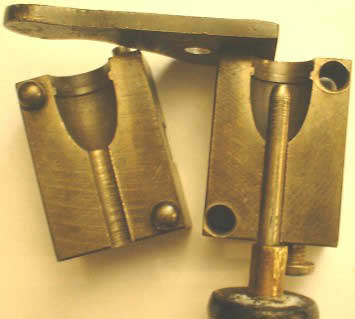 |
|
(Above)
The old converted Ideal 452374 HP |
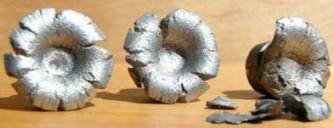 |
|
Lyman
452374 Devastator fired straight down into 3 feet of water with 6.5
Gr unique at 850 fps, alloy is clip-on WW plus 3% added tin. Even at
this modest velocity some of the bullets noses broke off with the
2-3% antimony alloy.
|
|
Lyman recognized this limitation of
the original 452374 HP design, and when they introduced their line of Devastator
HP bullet mould they came out with a radical departure from the traditional HP
concept. The .45 Devastator has a gaping .250" diameter mouth for rapid and
violent expansion (reminiscent of the "flying ashtray" which expands
beautifully, although it generates feeding problems in some guns). The conical
HP cavity of the .45 Devastator has a flat-based cavity, which can lead to
stress risers during the expansion process, and promote fragmentation. This
bullet weighs about 185 grains when cast with WW alloy and expands rapidly and
violently at .45 ACP speeds. Accuracy was very good in my guns with 7.5 grains
of Unique (1100 fps). I was rather surprised that there were no feeding problems
with this bullet in my guns, but it fed without a bobble (your mileage may
vary). When cast of a nice malleable alloy like 20 to 1 (lead to tin), this
bullet consistently forms beautiful little lead mushrooms when fired into a
water trough at 1100 fps, but with the more brittle antimony- containing alloys,
the thinner walls and sharp-cornered cavity bottom this bullet may fragment if
pushed too hard. The bottom-line is that this is a good bullet that expands
reliably, but there are some design features that aren't quite optimum for what
I had in mind (i.e. the mouth is too big, the sidewalls too thin, and the bullet
too light).
At this point, I feel that it is
important to emphasize that bullet expansion is a journey and not a destination.
What matters is what the bullet looks like in transit, not necessarily
what it looks like when it stops.
Mass retention is all well and good, but the bottom-line is that the wound
channel generated is more important than how pretty the bullet looks when it's
all said and done. Yes, if a bullet loses mass early, that can be a bad
thing as that robs the bullet of momentum, but if mass is lost later in the
wound channel, that is still acceptable if the wound channel is good (and good
wound channels come from a combination of adequate mass retention, frontal
surface area, and velocity, and mass lost late in the wound channel when the
bullet is traveling relatively slowly has very little impact on overall
performance). It is important to remind ourselves that the focus here needs to
be on the outcome, not obsessing compulsively on one single performance
metric.
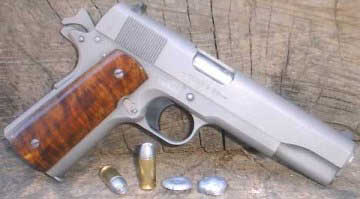 |
|
SS Colt 1911 and Lyman 452374 Devastator HP and
expanded bullets |
|
I have always been fond of the .45 ACP and the use of cast HP's in same.
In my experience, the Lyman 452460 200 grain SWC has consistently proven itself
to be one of the most accurate cast bullet in the .45 ACP. As a result, several
years ago I took a 452460 single-cavity mould and did a little lathe-work and
converted it to drop HP bullets. This bullet was built around a .165" cavity
mouth, that extends down about .350" down into the bullets (taper is
approximately 5 degrees). This bullet weighs about 185 grains when cast with WW
alloy and has proven to be VERY accurate. When loaded over 7.5 grains of Unique
it generates right at 1100 fps and expands beautifully. This is an excellent
bullet and has fed well in the pair of 1911s that I've shot it in, but some
people reportedly have problems with the SWC profile feeding poorly in their
guns (I never have, but I've heard this from enough other shooters to believe
that it's a real problem). The 452460 HP has shown itself to be an excellent
varmint bullet for the .45 ACP. I like it very much, but in the final analysis,
it's a little lighter than what I was looking for as a general purpose .45 ACP
HP.
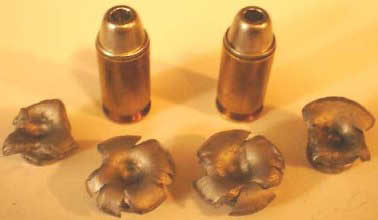 |
|
Lyman 452460 HP and expanded bullets (fragmentation
due to alloy used in test bullets) |
|
OK, so I wanted to combine the expansion properties of this 452460 HP
bullet, with the absolute reliability and extra bullet weight of the old 452374
RN. The old Ideal 452374 HP was a good first step, but didn't quite hit the
mark. The newer Lyman Devastator HP improved things considerably, but in some
ways overshot the mark (and removed too much bullet metal for what I was looking
for). I wanted a moderately large, conical HP cavity, with a rounded bottom, and
a well-defined flat meplat, and I wanted to preserve most of the round-nose
ogive for feeding reliability. The design criteria that I eventually settled on
for this bullet were: .250" meplat (a flat meplat surrounding the HP cavity
makes it easier to cast "keepers"), a .180" cavity mouth, a significantly
tapered cavity (7 degrees) that goes .300" down from the meplat (i.e. halfway
through the bullet for optimum mass retention at the moderate velocities of the
.45 ACP), a rounded HP cavity bottom, and maintain most of the RN ogive for
absolutely reliable feeding.
Erik Ohlen is the proprietor of
Hollow Point Bullet Mold Service, email at:
modify@hollowpointmold.com, (541) 738-2479). I have had Erik
modify a number of moulds for me over the past several months and in each case
he has done a superb job. Erik not only offers the service of converting a mould
to the traditional style of HP mould (i.e. a separate HP pin and keeper system),
but he also will convert moulds to the Cramer-style of HP, with captive HP pins,
compatible with multi-cavity HP mould casting, and capable of casting HP's VERY
fast. Erik has repaired factory Cramer moulds for me and he has converted other
moulds to the Cramer-style of HP; he understands this system and he executes the
concept beautifully. I found a used 2-cavity Ideal 452374 mould and sent it to
Erik with the instructions to convert it to a 2-cavity Cramer-style HP mould
with the specifications summarized above. My mould was returned a short while
later, modified exactly as requested.
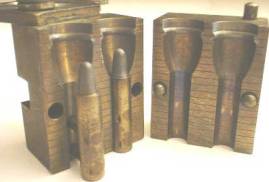 |
|
The Cramer-style HP conversion on the Ideal 452374
2-cavity mould |
|
Mounting the mould on handles, I waited as the lead pot heated up and
pre-heated the mould on the back edge of the pot. I had ten pounds of range
scrap in the pot. After the alloy melted, and I started casting, the mould was
cantankerous for the first several pours, requiring pliers to remove a couple of
the bullets off of the HP pins, in spite of the fact that Erik had obviously
flamed these pins to oxidize them. After about 5 or 6 pours, this tendency
towards stickiness disappeared and the mould started casting superbly (I don't
know why it was sticky initially, but the problem vanished after a few pours).
For the next 10 pounds of alloy that mould didn't drop a single defective
bullet, and I was casting quickly and smoothly. And oh by the way, it took me
less than an hour to cast those 10 pounds of bullets (that's about 350
bullets, or almost 6 HP's a minute) -- try THAT with a traditional single-cavity
HP mould! The HP cavities were perfectly centered and the bullets dropped easily
from the pins after everything got heated up. After they cooled down, the
bullets were found to weigh about 203 grains. This was just what I was looking
for, now it was time to get shooting and see if the design lived up to the
vision.
Test loads were assembled using Federal brass, CCI 300 primers and
Winchester 231, Unique, and HS-6. Ammo was loaded to an OAL of 1.265" and a
moderate taper crimp was applied. Initial test-firing was performed indoors at
50 feet with a Kimber 1911. It quickly became apparent that 1.265" was just a
touch too long and would bind slightly inside the magazine. The parent RN bullet
can be loaded to an OAL of 1.272" per the Lyman loading data, and I had guessed
that anything shorter than the original OAL would be OK. In hindsight, I had
forgotten to take into account the fact that I had shortened this bullet about
.040", so by shortening the OAL only .007", I was in essence moving the ogive
OUT by about .033", and that was enough to bind things up. Subsequent batches of
test loads were loaded up to an OAL of 1.240" and they functioned perfectly.
A very useful combination of velocity and accuracy was delivered with
7.2 grains of Unique (965 fps). Expansion tests with this load indicated modest,
but somewhat erratic expansion. Basically, these bullets had a tendency to open
up to full wadcutter profile, but would lose a couple of chunks out of the mouth
(recovered bullets weighed 180-185 grains). The range scrap alloy was acting
uncharacteristically hard and brittle, so I went back and measured bullet
hardness and found that these bullets had a BHN of 11-12. Previously this range
scrap had been consistently running around BHN of 7.5 to 8, and HP’s cast of
this alloy would expand beautifully, so clearly as I got down towards the bottom
of my ingot bucket I had gotten into some harder, more brittle alloy (always a
risk when using recycled bullet metal of unknown composition).
For the next batch I melted up a little over 6 lbs of pure lead
sheathing and added 1/2 lb of 50/50 solder to make 25-1 alloy. This sort of
binary lead/tin alloy tends to be far more malleable, and less brittle than the
tertiary alloys containing antimony, and 25-1 alloy should have a BHN of about
8.5-9.0. 45 minutes later, this casting session ended with the prettiest little
pile of shiny, perfectly formed HP’s you ever saw! They weighed 210 grains when
cast of 25-1 alloy. Soft, heavy and malleable -- a fine recipe for cast HP’s at
moderate velocity. Test loads were once again assembled with 7.2 grains of
Unique, and they grouped just fine at 50 feet. Expansion testing in wet
newsprint revealed superb performance. All 5 shots expanded beautifully to
greater than .80 caliber. All 5 recovered bullets weighed 209-210 grains, for
essentially 100% weight retention. Penetration averaged about 6 1/2" into the
expansion medium (previous experience has shown that penetration in ballistic
gelatin is about twice that observed in wet newsprint, suggesting that this load
would give 13-14" of penetration in ballistic gelatin). "Wound channels" in the
wet newsprint were on the order of 1" to 1¼” in diameter. This was exactly the
sort of performance I was looking for. The project was deemed a success.
|
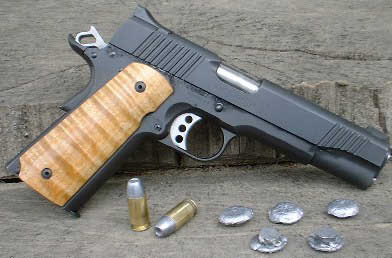
|
|
Expanded 452374 HP's with the Kimber 1911 |
Yes, John Moses Browning was a genius; and the 1911 .45 ACP is one of
the finest defensive sidearms ever built, but the traditional RN bullet is not
the most effective projectile for the 1911 platform. Cast HP’s can significantly
improve the terminal performance of the .45 ACP over the traditional RN. The
Lyman 452374 Devastator HP is an excellent bullet, but its huge HP cavity
(intentionally put in place so the bullet would expand when cast with WW alloy)
makes it lighter than desired, and potentially prone to fragmentation. The
conversion performed by Erik Ohlen on this Ideal 452374 2-cavity mould to
produce a Cramer-style 2-cavity HP mould resulted in a mould that is capable of
turning out 210 grain cast HP’s that are ideally suited for the .45 ACP, and
allows the caster to crank out a bunch of HP’s in a hurry -- the perfect way to
complete the story of the 1911 .45 ACP!
|